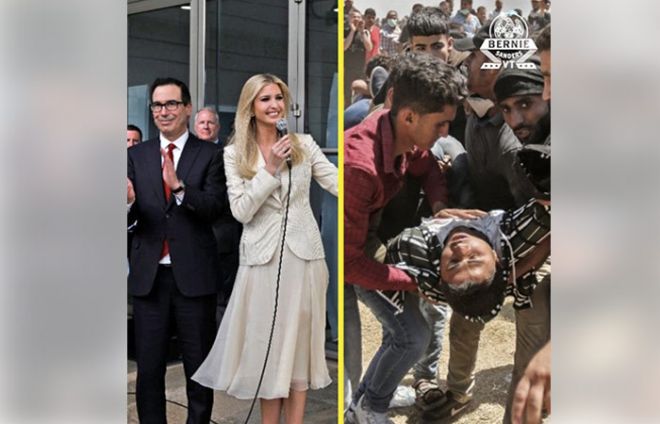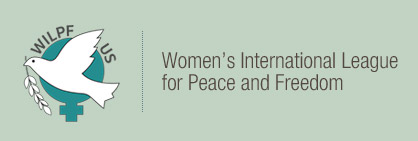Developing a Peace Movement Middle East Agenda
Published on June, 35 2018
Photo source: US Campaign for Palestinian Rights
By Odile Hugonot Haber and the Middle East Committee
Since Israel attacked the US ship “Liberty,” a ship the US had sent to monitor the Suez Canal in the beginning of the Six Days War (1967), relations between the US and Israel have become increasingly close and their military industries have become tied together.
After the 1967 War, “The heroic Israeli David triumphed over the aggressive Arab Goliath” writes Phyllis Bennis. “After that support skyrocketed for US closer ties to Israel.” (1) “...The reward for Israel was a flood of sophisticated weapons, including advanced Phantom Jets.”
Since then US military aid to Israel has grown by leaps and bounds as as our own US military budget has ballooned. Israel was there to protect “our oil” under “their sands,” and we know that corporate US interests have to be protected at all costs.
Now Israel possesses the technological know-how to produce their own arms industry: anti-tank missiles, guided bombs, anti-missile defense systems—“David’s Slings and Iron Dome.” Israel also has a sophisticated aerospace industry: satellites, robotics, cyber warfare, drones, etc. Israeli arms and components are exported by SIBAT, the International Defense Cooperation Directorate of the Israel Ministry of Defense. Their website states that Israel Defense sales grew by 40% in 2017. According to SIBAT, in 2017 Israel exported missiles aerial defense systems (31%), radar systems (17%), avionic (14%), and so on.
Israel also has the only nuclear arsenal in the Middle East so far, estimated to include 120 nuclear bombs, and submarines with long-range nuclear missiles.
So between Israel and the US, there are unique high-tech defense weapon systems that manufacture weapons and propagate them around the world for warfare. They also upgrade and retrofit other countries “platforms” This is called “Israelizing platforms.” Israel has received $121 billion in aid (overwhelmingly military in nature) from the US between 1949 and 2015. (2)
Besides this giant military industrial complex, what are the other aspects of US policies in the region?
Because the US has decided it is important to protect this defense industry development and protect Israeli hegemony in the Middle East, Lebanon had to be controlled and bombed from time to time to disarm their economy and infrastructure, and to keep Hezbollah at bay.
After Iraq, Syria had to go. The Islamic States grew at first with US weapons and US support, but eventually grew too powerful and had to be fought. Divide and conquer is a good tactic, and the neocons had first used such tactics to gain dominance over Latin America with the aid of Israeli knowledge in population control. Now this policy has been exported to the Middle East. (3)
Then the Islamic State, al-Qaeda, the Taliban, and Hamas had to be defeated, and Syria, Yemen, and Iran had to be “contained.” This reflects the breath of the regional crisis.
A continued US military presence has to be maintained to prevent any resurgence in Iraq, Libya, Syria, or Lebanon, and has to be continued no matter what any US president may declare. Building counter terrorism is crucial.
This “Armageddon” scenario is not diminishing, and we have to remember that there is also a vague US process that is part of the Geneva Accord which has not proceeded successfully in recent years.
Gaza may be the heart of an open sore but the wound had grown wider. The Middle East and the planet are in grave danger due to out of control militarization.
Would it not be better to invest our tax dollars in climate change, focusing on the lack of water and the unbearable heat that grows every year and will eventually make any human life impossible in these various regions? It is time for swords into plowshares...
What agenda could the peace movement develop against “this hegemonic and pacification program”?
We could:
Create forums that would let people express their grievances, do a Sulha (a regional conflict resolution method) and honor local people. We could build on the multiple theologies that exist for Peace and Justice.
Recall the Universal Declaration of Human Rights, and put it first in all deliberations.
Divest from bombs and the war system, create an alternative policy and press for it.
(See the AFSC’s Principles for a Just and Lasting Peace between Palestinians and Israelis)
Create a “Weapons of Mass Destruction Free Zone” in the Middle East, and continue to promote it as an alternative to the arms race.
Convene the citizens of the world to a peace meeting for the Middle East.
Call our representatives and move them forward, asking them not to support the 3.8 billion per year the US gives Israel. Instead we could have public school education, decent housing for all, and health care.
Call your DC Representatives and Senators (1-202-224-3121)
E-mail addresses for Reps can be found at www.house.gov
E-mail addresses for Senators can be found at www.senate.gov
Sources
- Phyllis Bennis, Understanding the Palestinian-Israeli Conflict: A Primer (Olive Branch Press, 2015).
- Jeff Halper, War Against the People: Israel, the Palestinians and Global Pacification (Pluto Press, 2015).
- Roxanne Ortiz-Dunbar, An Indigenous Peoples’ History of the United States (ReVisioning American History) (Beacon Press, 2015). WILPF is mentioned in this book, for helping Native people to present their grievances at the UN.



